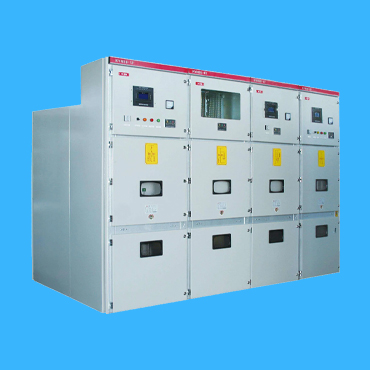With the widespread application of 6kV to 35kV medium and low voltage switchgear in an electrical distribution system, the number of power supply and distribution equipment damage accidents caused by arc short circuit faults inside the switchgear is increasing. When a short circuit fault occurs inside the medium and low voltage switchgear, the phenomenon of arc light will inevitably occur, and arc light is the energy source of power supply equipment damage. At present, the number of unmanned substations in the power grid is rapidly increasing, but there is a weakness of inadequate protection. Due to the failure of arc short circuits in the switchgear to be cleared in a timely manner, it has developed into medium and low voltage bus faults, and the accident scope has expanded. The high temperature, high voltage, and high energy of arc short circuits usually burn out the entire bus equipment, causing a serious accident of large-scale power outage in the power supply area of the substation, and thus causing significant economic losses. Therefore, it is necessary to install fast and reliable arc protection devices in the 6kV to 35kV medium and low voltage switchgear, quickly detect and remove arc short circuit faults in the switchgear, prevent accidents from expanding, and improve power supply reliability. 
Analysis and characteristics of arc flash caused short circuit faults
Arc short circuit fault is a common fault in the power system, which can be caused by insulation damage, foreign object entry, human operation errors, equipment aging, and system related reasons. Arc is a phenomenon that occurs during the discharge process, when the voltage between two points exceeds its power frequency insulation strength limit. When the voltage between two points increases, the positive and negative ions in the air near the electric field are accelerated by the electric field, colliding with other air molecules during movement to produce new ions. This phenomenon of a large increase in ions is called “ionization”. When the air is ionized, the temperature rises sharply and produces an arc, which is called arc discharge. Arc discharge generally does not require a high voltage and belongs to low voltage and high current discharge. As long as the energy provided by the voltage at both ends of the discharge point is sufficient to compensate for heat loss and maintain appropriate temperature conditions, the arc will continue to occur. If the arc is elongated and cooled, it will be extinguished due to the necessary conditions for maintaining it. Arc discharge can be divided into arc between charged conductors, arc between charged conductors and ground, and creepage on insulation surfaces according to the different parts of the arc that occur. The harm degree of Arc fault depends on the arc current and switching time. The energy generated by the arc rises exponentially, according to the provisions of IEC 62271-200 standard and IEEE C37.20.7 standard. The time that the switchgear can withstand internal discharge arcing is only lOOms. The switchgear sold in the market at present is basically manufactured according to IEC standards. When the total switching time is greater than lOOms, it will cause damage to the equipment to varying degrees. In practice, when an arc short circuit occurs in the middle and low voltage switchgear, the short circuit current often cannot reach the set value of overcurrent and quick break, and cannot quickly cut off the fault. The result of the continuous burning of the arc is the release of enormous energy. Due to not being cleared in a timely manner, it developed into a medium voltage bus fault, burning the switchgear and causing a power outage in the substation.
The process of forming an arc inside the medium and low voltage switchgear can be divided into four stages. 1) Compression stage: The arc occupies the entire air space. The air inside the cabinet is heated; 2) Expansion stage: The pressure inside the cabinet increases, reaching a high value during this stage, and begins to weaken due to the release of hot air; 3) Launch stage: due to the continuous release of arc energy, almost all the air in the cabinet is squeezed out by pressure; 4) Heating stage: After expelling the air, the temperature inside the cabinet almost reaches the temperature of the arc until it extinguishes. At this point, all metals and insulators merge after being eroded by the generated gas, mist, and particles of corrosive substances.
The local high temperature at the fault point where an arc occurs can reach 2000 ℃ to 3000 ℃, which can easily ignite surrounding combustible materials. It may not only burn down switchgear, wires, and cables, but also cause malignant electrical short circuits and trigger a fire. In places with personnel on duty, electric arc light may also cause strong light, burns, radiation, toxic gases, and other personal injuries to operators.
Arc short circuit faults in substations usually begin with single-phase grounding, as the neutral point is not grounded and allows for a short period of operation after single-phase grounding. During this period, unstable intermittent arc grounding is easily formed at the grounding point. Thus, overvoltage is generated and the weak insulation in the system is broken down. At the same time, a strong arc will cause a two-phase or phase short circuit, forming a phase to phase arc short circuit, causing serious damage to electrical equipment and endangering power supply.
Working principle of arc flash protection
Arc protection mainly controls the total fault removal time within the arc burning time that the switchgear can withstand by detecting arc light and fault current, reducing the harm of arc short circuits to a minimum. The arc light protection system measures parameters with completely different physical properties between light and electricity. The system utilizes the criterion principle of light and electricity. When both criteria meet the action requirements, a tripping command is issued to trip the circuit breaker. The current response speed of arc light protection only takes 5ms to 7ms from detecting arc light to relay tripping output.
A set of arc flash protection device is pre-installed inside a medium switchgear to quickly protect the busbar and cable head in case of arc short circuit fault, which can avoid serious damage to equipment and personnel caused by the arc light generated during arc fault. Install arc point sensors in the busbar compartment and cable head compartment of each circuit. When an arc fault occurs in the busbar compartment, quickly disconnect the incoming circuit breaker and busbar connection circuit breaker of this section of electrical busbway; When an arc fault occurs in the cable head compartment, quickly disconnect the outgoing circuit breaker without affecting the busbar and other circuits, expanding the fault and reducing the power outage range.
The arc flash device consists of a control main unit, I/O unit, arc light sensor, and communication connection cable. The main function of the main control unit is to receive the arc light signal of the direct arc light expansion unit and detect two groups of three-phase current, zero sequence current and zero sequence voltage. By processing the received data and using the dual criteria of current overcurrent and arc light, programming is carried out to issue a tripping command. Simultaneously continuously self checking all units, with circuit breaker failure protection and arc fault positioning functions; The main function of the arc expansion unit is to connect multiple arc sensors (up to 12 arc sensors can be connected), which solves the problem of limited access interfaces for the main control unit’s arc sensors. After receiving the arc signal, the arc signal is transmitted to the main control unit to complete the tripping output of the cable head arc protection. The arc sensor has a detection range of 270 ° and is directly connected to the arc expansion unit for real-time monitoring of arc light. Communication cable: Transmits power, monitoring signals, and trip signals between the main control unit, expansion unit, and arc sensor. At present, the setting value of the arc protection device should be less than the setting value of the main transformer backup protection overcurrent section I, and the protection action time should be less than 5ms.
PowerTel & his expert engineers are ready to answer any technial questions about electrical switchgear and a tailored design of an switchgear for your power distribution system , please feel free to contact us at info@powertel-solutions.com
